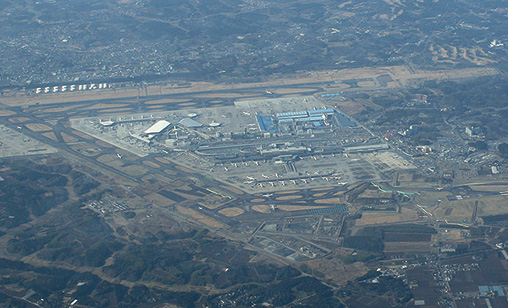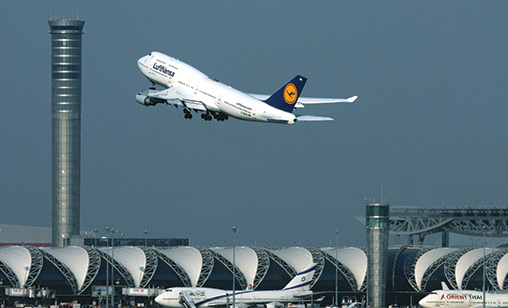News Backgrounder
No where to grow
As Asia-Pacific airport traffic continues to outpace forecasts, the growth is prompting more warnings from carriers that governments must accelerate their infrastructure expansion.
March 1st 2016
When a number of Asia-Pacific airports released their detailed traffic statistics for 2015 it confirmed the predictions of airlines that airports will face serious congestion if they don’t fast track infrastructure expansion. Read More »
 |
In 2015 at Tokyo Narita international airport, which already is squeezed for slots, domestic and international passengers hit a record high in 2015, for the second consecutive year. They increased by 5% over the previous year, to 37.32 million. The growth, including a 23% increase in foreign visitors, to 12.49 million, reflected a surge in visitors to Japan as the Yen declined and domestic flights operated by low-cost carriers increased, said the Narita International Airport Corporation.
It was a similar story at Osaka’s Kansai International Airport. For the first time since it opened in 1994, foreign travelers topped 10 million in 2015, a 59% increase over 2014. Passenger traffic hit a record 23.21 million, with the number of people on international flights jumping 24%, to 16.25 million, also a record. Domestic passengers grew 11%, to 6.96 million.
Hong Kong International Airport (HKIA), the third busiest airport in the Asia-Pacific, also set records for passenger traffic and aircraft movements in 2015, bringing it closer to full capacity. Following a record-breaking 2014, the airport’s traffic volumes continued to surge last year, with 68.5 million passengers and 406,020 flight movements, growth of 8.1% and 3.8%, respectively. The airport’s cargo throughput also reached a record 4.38m tonnes.
“Expanding the airport into a three-runway system (3RS) is the only option for us to meet long-term air traffic demand,” said Airport Authority Hong Kong chief executive, Fred Lam. “We will continue the preliminary work on the 3RS project, aiming to commence construction this year,” Lam said.
It is a similar story across the region. In February, Thailand reported its six main airports had robust passenger growth of 21.3% last year, setting a record of just under 110 million passengers for 2015.Airports of Thailand (AoT) said the expansion momentum is expected to continue in 2016 and conservatively projected 11% growth in combined passenger numbers for the year.
 |
Bangkok’s Suvarnabhumi, the gateway to Thailand, accounted for the lion’s share of air traffic, handling 52.9 million passengers last year, up by nearly 14% over the previous 12 months. Its official passenger capacity is 45 million a year. The city’s second airport, Don Mueang, had the strongest passenger growth, not only in Thailand but in the region, as surging low-cost carrier traffic pushed the facility well beyond its limits. Passengers using Don Mueang leapt 40.7%, to 30.27 million, with international numbers jumping 53.1%, to 9.17 million, and domestic passengers growing to 21.1 million, an increase of 35.9%.
The director general and CEO of the International Air Transport Association (IATA), Tony Tyler, wrote in a recent commentary in Japan’s Nikkei Asian Review that historically, the Asia-Pacific had shown leadership on infrastructure. “It is home to several of the world’s best and biggest airports. The Asian travel experience is certainly among the most pleasant in the world,” he wrote.
“It will not stay that way without continuous hard work, strategic investment and regional cooperation. Singapore, Hong Kong and Seoul are legendary for great passenger experiences. But there are some regional bottlenecks to sort out.
“For example, you would be hard-pressed to find anybody singing the praises of the airports in Jakarta or Manila and comments on Bangkok’s Suvarnabhumi airport are as likely to be about its crowded corridors as about its great shopping experience,” Tyler said.
“Building the infrastructure to meet growing demand for people and businesses to connect by air is a global challenge, he said. “The pressure is most intense in the fast growing Asia-Pacific, where airports and skies will need to handle 2.5 billion more passengers than they do today.”
Tyler said that all the region’s aviation infrastructure will come under increasing demand as the Association of Southeast Asian Nations’ (ASEAN) single aviation market policy comes to fruition. “Every market that has liberalized has seen an economic boost as people’s needs for connectivity were fulfilled. There is no reason to believe that the ASEAN experience will be any different. Cost-efficient infrastructure must be available to accommodate demand,” he said.
Association of Asia Pacific Airlines (AAPA) director general, Andrew Herdman, said: “Looking at the region’s forecast of 5% to 6% continuing annual growth, and with the region projected to order around 40% of all new aircraft over the next 20 years, the AAPA is concerned that adequate provision be made to accommodate the expansion.
“Most big hub airports, such as Singapore and Seoul, are ahead of the game, but red tape is causing bottlenecks elsewhere,” he said.
An example of cumbersome bureaucracy inhibiting airport development is the proposed Long Than International Airport, to be built outside Ho Chi Minh City. It will be Vietnam’s largest airport, but it will likely be inaugurated five years behind schedule if it follows procedures as required, the National Assembly Economic Committee in Hanoi has warned.
To complete all procedures would mean that site clearance won’t start until 2020 and land acquisition by 2023, the committee said. Construction could commence as late as 2030. The $16 billion airport, with a capacity of 100 million passengers and five million tonnes of cargo annually, would not be completed until 2050.
Many believe that even in China, one of the worst areas for airport and airways congestion, the $11.7 billion being spent this year on the construction of civil aviation infrastructure is insufficient to solve forecast air traffic and airport congestion.